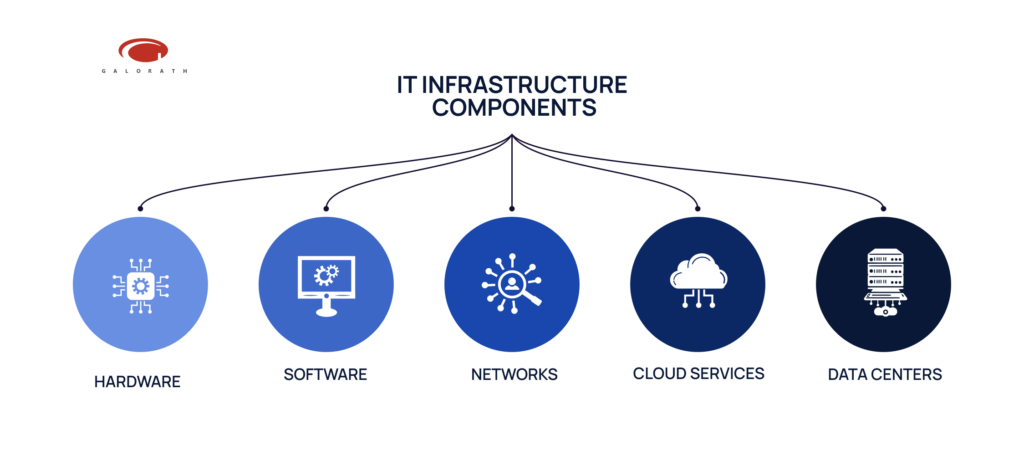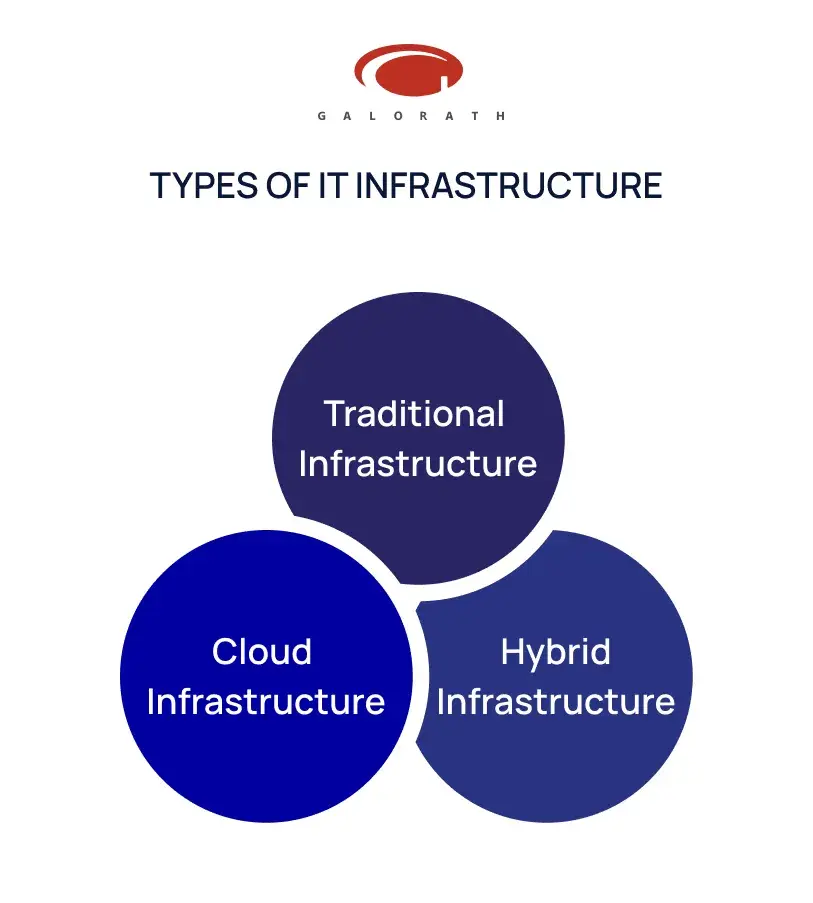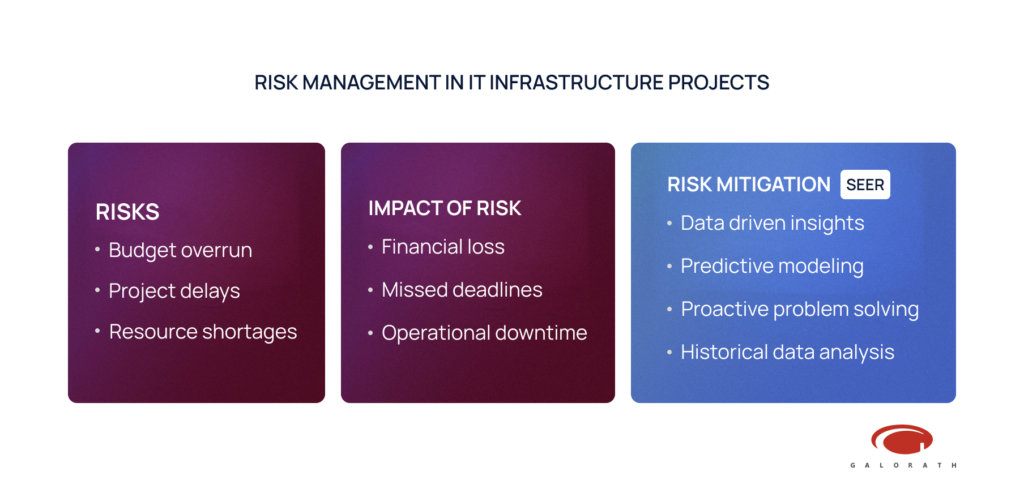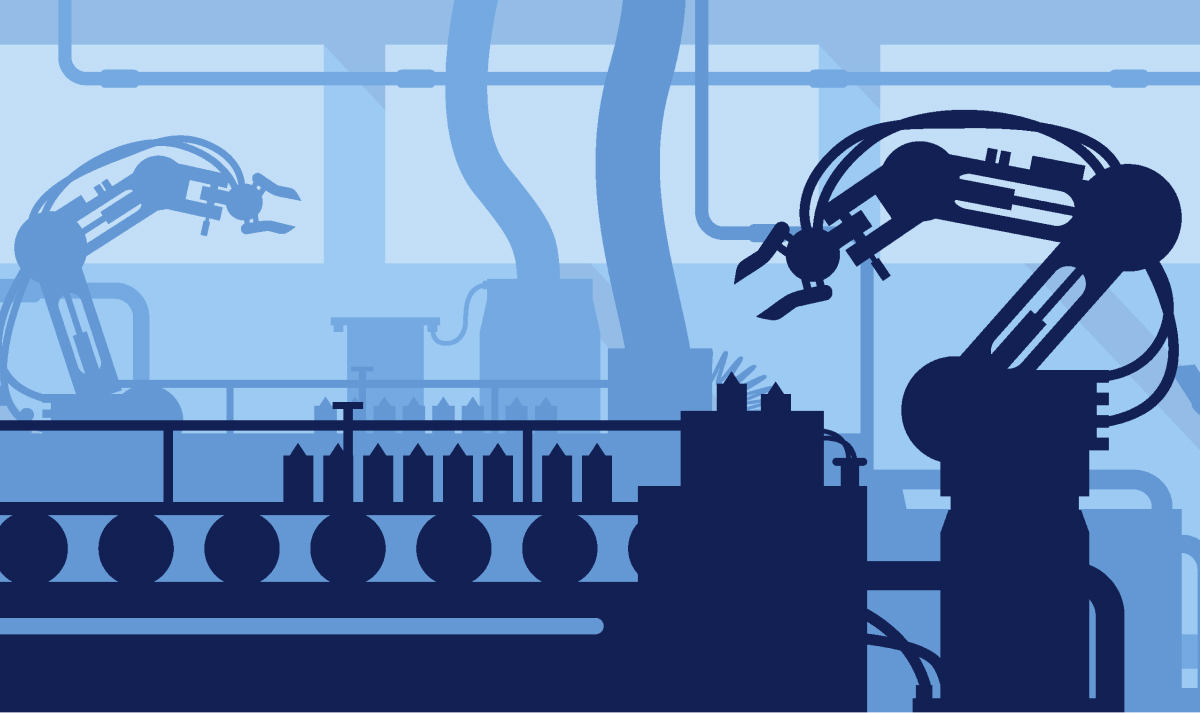Mastering Cost Risk with the CRED Model: A New Approach to Managing Uncertainty

IT infrastructure forms the backbone of modern organizations, integrating the essential hardware, software, and network resources needed to manage and deliver IT services effectively. It supports businesses in operating their IT systems efficiently and reliably.
CIO.gov, defines IT infrastructure as “the set of hardware, software, and network resources needed for the management and delivery of IT services.” This highlights its multifaceted nature, covering physical devices like servers and software applications that streamline organizational processes.
Table of Contents
Key Components of IT Infrastructure
The key components of IT infrastructure include hardware, software, network infrastructure, data centers, and security measures. Each component plays a role in the overall performance and effectiveness of an organization’s IT environment.

Hardware Components
At the foundation of IT infrastructure lie its hardware components. These physical assets, including servers, routers, switches, and storage devices, are essential for maintaining operational continuity. Without reliable hardware, organizations cannot support the applications and services that their users depend on.
Software Infrastructure
Complementing the hardware is the software infrastructure, which encompasses operating systems, applications, middleware, and management tools. This software ecosystem allows hardware components to perform their designated functions. Without the right software, even the most sophisticated hardware becomes underutilized or ineffective.
Network Infrastructure
The next component is network infrastructure, which includes local area networks (LANs), wide area networks (WANs), and the various protocols that facilitate data communication. A reliable network infrastructure is essential for enabling seamless connectivity and communication within an organization. It serves as the lifeline for information exchange, allowing teams to collaborate effectively and access the data they need to drive business success.
Security Infrastructure
With the increasing prevalence of cyber threats, security infrastructure has become an indispensable aspect of IT. This includes firewalls, encryption technologies, intrusion detection systems, and access control measures that protect an organization’s sensitive data. A comprehensive security infrastructure is essential not only for compliance but also for maintaining customer trust and safeguarding the organization’s reputation.
Data Centers and Cloud Services
Data centers serve as the backbone of traditional IT infrastructure, providing physical space for servers and storage, while cloud services offer flexible and scalable alternatives that allow organizations to leverage resources without the need for extensive on-premises hardware. When discussing IT infrastructure, it’s essential to differentiate between traditional data centers, cloud services, and hybrid infrastructure models.
Types of IT Infrastructure: Traditional, Cloud, and Hybrid
Understanding the different types of IT infrastructure is crucial for modern organizations. Each type has its strengths and weaknesses, making it essential to evaluate which model aligns best with organizational needs.

- Traditional Infrastructure: This model involves hosting all hardware and software on-premises. Organizations have complete control over their data and systems, but this also means they are responsible for all maintenance and updates. This model can lead to high capital expenditures and requires significant IT resources.
- Cloud Infrastructure: Cloud-based solutions offer flexibility and scalability, allowing organizations to pay for only what they use. With cloud infrastructure, businesses can easily scale resources up or down based on demand, leading to potential cost savings. This model often involves reliance on third-party providers, which creates data security and compliance concerns.
- Hybrid Infrastructure: A hybrid model combines on-premises and cloud solutions, providing organizations with the flexibility to choose the best environment for their specific needs. This approach allows for optimal resource allocation while ensuring that sensitive data can be kept on premises when necessary.
Why is IT Infrastructure Management Important?
A well-designed IT infrastructure supports organizational agility, security, and scalability. With today’s fast paced business environments, organizations have to adapt to change quickly, respond to customer needs in real-time, and maintain high levels of operational efficiency. An effective IT infrastructure management enables organizations to achieve these goals by providing the necessary tools and resources to operate smoothly.
Furthermore, scalability is vital for accommodating growth. As organizations expand, their IT infrastructure must be capable of evolving alongside them. A flexible and scalable infrastructure allows businesses to adjust their resources based on demand, ensuring that they can meet their operational needs without incurring unnecessary costs.
Optimizing Hardware, Software, and Network Infrastructure with Galorath
Sizing and managing hardware infrastructure are vital for meeting both current and future demands. Organizations can significantly benefit from Galorath’s SEER for Hardware, which aids in accurately estimating costs related to hardware acquisition and lifecycle management. By providing precise cost estimations, businesses can effectively budget for their physical assets, thus preventing financial shortfalls that could disrupt IT operations.
Continuous maintenance and updates are needed for adapting software infrastructure to evolving business needs. Galorath’s SEER for Software predicts costs associated with software development, implementation, and maintenance, including custom applications and ERP systems, ensuring organizations make informed decisions about their software investments and maximize the value derived from their infrastructure.
Network infrastructure needs to be designed with both scalability and security in mind. Utilizing Galorath’s predictive analytics tools enables organizations to model their network infrastructure needs, facilitating effective planning for capacity and resource optimization.
This strategic foresight allows businesses to scale their networks to accommodate current demands while preparing for future growth, ensuring that their IT infrastructure remains robust and responsive to changing organizational requirements. By leveraging these capabilities, organizations can optimize their hardware, software, and network components, fostering a resilient IT environment that supports long-term success.
Cost Estimation and Budgeting for IT Infrastructure
Accurate cost estimation is paramount when establishing, maintaining, or upgrading IT infrastructure. Miscalculations can lead to overspending, resource shortages, and ultimately project failure. Understanding the true cost of IT infrastructure is essential for successful planning and execution.
Galorath’s SEER for IT equips organizations with the tools needed to estimate infrastructure costs comprehensively. By simulating various scenarios, organizations can make informed decisions regarding scaling, resource allocation, and investment. Accurate budgeting ensures that IT projects remain aligned with organizational goals, facilitating efficient financial management and resource allocation.
Risk Management in IT Infrastructure Projects
IT infrastructure projects bring organizations a variety of risks, including budget overruns, project delays, and resource shortages. These challenges can jeopardize not only the individual projects but also broader organizational goals. Therefore, implementing a robust risk management strategy is crucial.
Historically, many IT projects have fallen victim to unforeseen circumstances, leading to significant financial and operational consequences. To mitigate these risks, organizations must rely on data-driven insights and predictive modeling. By leveraging advanced algorithms and historical data analysis, organizations can identify potential problem areas before they impact project timelines and costs.

By utilizing these insights, businesses can proactively address challenges, ensuring that their projects remain on track and within budget. This approach is particularly valuable for complex projects where multiple variables must be managed effectively.
SEER supports Strategic Decision-Making
In an increasingly competitive environment, IT managers and C-level executives must make strategic decisions that align with their organization’s goals. Choosing the right infrastructure model, whether traditional, cloud, or hybrid, requires careful consideration of various factors, including cost, performance, and long-term sustainability.
Understanding the definition and components of IT infrastructure is fundamental, from hardware and software to security measures and network resources, each element plays a vital role in ensuring operational success.
By leveraging the tools and insights provided by Galorath, organizations can navigate the complexities of IT infrastructure, making informed decisions that align with their strategic objectives and drive long-term success. As businesses continue to evolve, the importance of a well-planned and managed IT infrastructure will only grow, reinforcing its role as the backbone of modern organizations.
10 Step Estimation Process Sample Checklist
View our 10 Step Estimating Process Checklist. This checklist should be tuned to the individual company’s needs and suggestions.
Estimating Total Cost of Ownership (TCO)
Find out how you can use Total Cost of Ownership (TCO) model to create an estimate which includes all the costs generated over the useful life of a given application.
Should Cost Analysis
Learn how Should-Cost Analysis can identify savings opportunities and drive cost efficiency in procurement and manufacturing processes.
ROM Estimate: The First Step Towards a Detailed Project Plan
Find out what ROM (rough order of magnitude) estimate is and why is it a crucial element of every project planning cycle.
Software Maintenance Cost
Find out why accurate estimation of software maintenance costs is critical to proper project management, and how it can make up to roughly 75% of the TCO.













